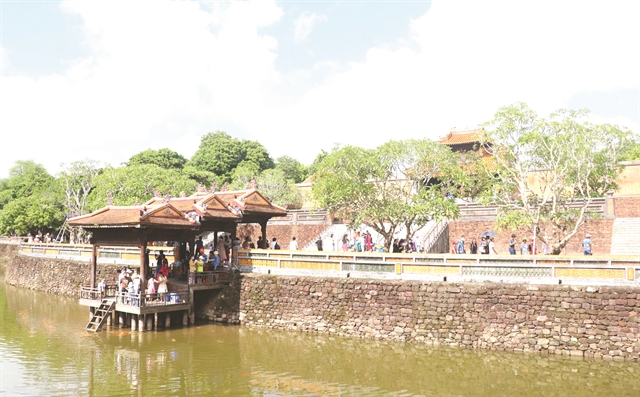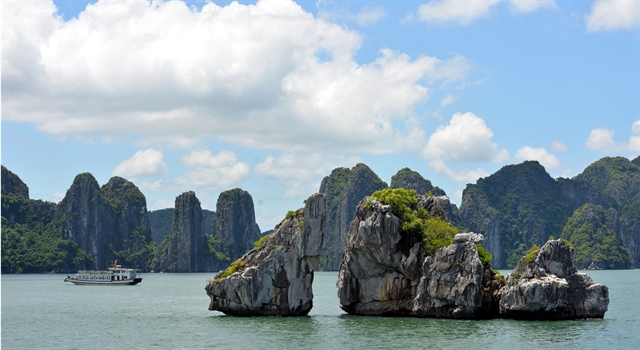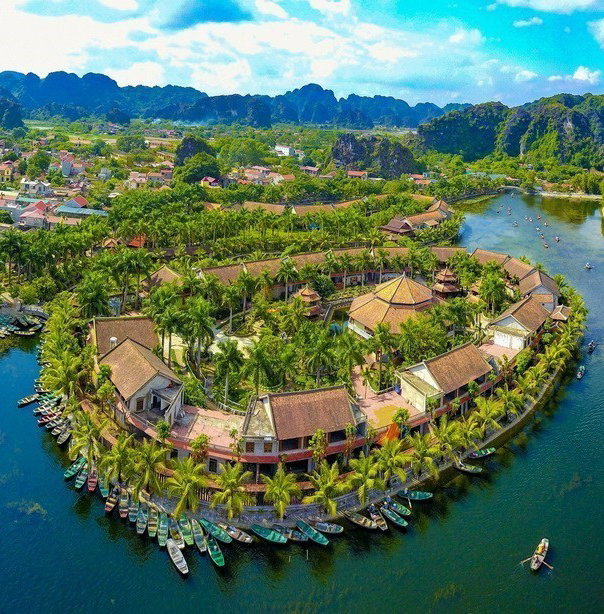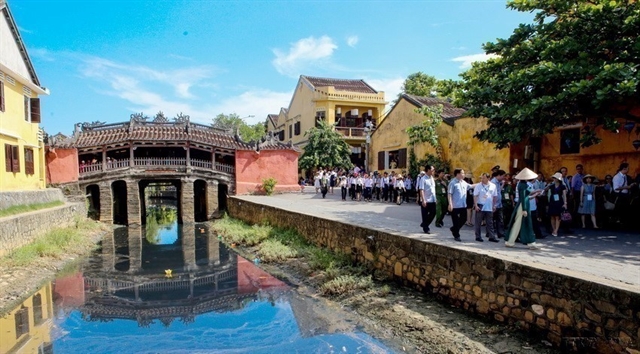 Sunday/Weekend
Sunday/Weekend

 |
| PICTURESQUE: King Tự Đức Tomb in Huế, a UNESCO heritage site, is a magnet for visitors. VNA/VNS Photo Tường Vi |
by Nguyễn Mỹ Hà
Tourism in Việt Nam is back and running at full speed both in the private sector and on a national level. Meanwhile, national conferences bring local tourism experts and international heads of cultural establishments together to map out pathways for cultural and heritage tourism to soar in a country that has 17 UNESCO World Heritage sites.
Inbound trips have started to flourish again, with meetings industry trips, or exploration and trekking tours to signature and newly discovered spots in the provinces of Quảng Bình and Quảng Nam, in addition to the beautiful mountain rides among the northwestern and northeastern slopes with Hà Giang being the much-desired destination for both local and international visitors.
 |
| HINDU RELIC: Mỹ Sơn Sanctuary in Quảng Nam Province preserves the tombs of the royal kings and queens of the great Champa Kingdom. VNA/VNS Photo Đỗ Trưởng |
Cultural tourism
This year, the Việt Nam Tourism Association has chosen "Cultural Tourism" as the theme for the Việt Nam International Travel Mart, to be held in Hà Nội from April 13-16.
"We hope that this event shall be the opening of a new wave in tourism for cultural travel to develop, honour and celebrate the cultural and historical traditions of Việt Nam," said Vũ Thế Bình, chairman of the Việt Nam Tourism Association.
"Currently, cultural tours have not been categorised as a trend or a section of the larger tourism industry. If we look at current tourist products, we can see the cultural aspects of cultural tourism such as tours to visit religious destinations, cultural festivals or food tours, are part of ongoing tours."
He said that more work needed to be done to define this particular segment of the tourism industry, where the needs of tourists, as well as the cultural agenda, must be factored into an itinerary or established tours.
 |
| NATURAL WONDER: Hạ Long Bay, one of Việt Nam's best known landscapes and a UNESCO World Heritage Site, drawing millions of people every year. VNA/VNS Photo Thanh Vân |
For a long time, Việt Nam was known as a country ravaged by wars, and it has become known recently as one of the fastest growing economies in Southeast Asia, but eventually, it can leave its impact on the world travel map for its cultural traits and history.
This year also marks the 80th anniversary of the "Việt Nam Culture Outline", penned in 1943 even before the August Revolution succeeded in 1945, which declared that Việt Nam was an independent republic and ended the rule of French colonialism and the Nguyễn Dynasty.
"Culture shall be the common ultimate destination, we as a country leave an impact on the world scene," Bình said. "Việt Nam's cultural and historical heritage will be the alluring aspects that bring international visitors to the country."
The International Conference Promoting the Role of World Cultural and Natural Heritages in Sustainable Development for Việt Nam, held on March 24 in Hà Nội, heard local authorities voicing their concerns in managing heritage and cultural sites.
At the conference, Director of the UNESCO World Heritage Centre Lazare Eloundou Assomo told the audience that Việt Nam was a role model in managing, preserving and promoting the values of heritage, and hoped that it would share its experience with others.
This year Việt Nam marks its 35th anniversary of when it ratified the 1972 World Convention on Cultural Heritage, and a series of cultural activities, tourism conferences and travel marts have been organised.
But the preservation of cultural and natural sites must rest heavily on the shoulders of the community, where heritage sites are located.
Having visited three heritage sites -- Thăng Long Citadel, Tràng An and Hạ Long Bay -- Director Assomo said: "If there is something that I can keep in mind from the trip, it is the understanding of how this heritage is so important to people."
Citing Thăng Long Citadel as essential not only for Hanoians, but for the whole of Việt Nam, as symbol of the nation, he said that he was also moved by the fact that heritage sites in Việt Nam were also a source for socio-economic development.
"Tràng An, for instance, contributes to the livelihood of the community and the empowerment of women," he added.
 |
| BIRDS-EYE VIEW: Tràng An has become Việt Nam's first combined heritage of both cultural and natural sites. Home to the first royal capital city in Hoa Lư and diverse natural beauty, it is the pride of all Vietnamese. VNA/VNS Photo Minh Đức |
Development challenges
Phan Hộ, director of the Mỹ Sơn Sanctuary management board, told the conference: "It is key to ensure that the thousand-year-old relics of Mỹ Sơn Sanctuary are not intervened with, renewed, or be affected to the level they lose their authenticity, value or status. Over a short period of time, wars had wrecked havoc on the 70 relics found by the French, only 20 survive today."
"When we need researchers to uncover the myths of construction at Mỹ Sơn to better preserve them, we also need the local economy to grow to eradicate hunger and reduce poverty in the neighbourhood, providing local people with support to keep protecting the ruins from further decay."
Since Mỹ Sơn Sanctuary was recognised as a UNESCO World Heritage Site in 1999, the local government has found it easier to draw tourists to the region.
Mỹ Sơn could have learnt a lesson or two from its neighbouring Hội An.
The director of Hội An Centre for Cultural Heritage Management and Preservation, Phạm Phú Ngọc, said that the challenges for Hội An was that people made a living from the heritage, thus Hội An can be dubbed a "Living Heritage" site.
Hội An must be regulated not only by heritage laws, but also abide by other administrative regulations of a well-functioning urban centre, like other cities and towns of similar sizes and population.
A preservation process need not only to follow construction rules, but also strictly follow cultural heritage rules, where the daily comfort of the people must also be giving into preservation requirements. The benefit of each family, each individual living in the common heritage site, must be in harmony with the larger requirement of preserving the heritage of the whole city and community.
 |
| ANCIENT TOWN: Hội An's iconic Tiled Roof Bridge has never ceased to appeal to visitors. VNA/VNS Photo Trần Lê Lâm |
Having been threatened by the development challenges like Mỹ Sơn and Hội An, the tourism authorities in Hạ Long Bay found their way of enduring stability, by slowly establishing alternatives to the floating fishing village, where fishermen used to live and making their ends meet at sea.
It is possible for a heritage site to change and adapt but stick true to its routes and continue to attract tourists.
Lê Minh Tân, deputy head of the Hạ Long Bay Management Board, said that Quảng Ninh authorities had to come up with a checklist of usable eco-friendly materials, making sure to protect the natural landscape, geological significance, as well as historical and cultural aspects.
The Hạ Long Bay Management Board has managed to retain part of the old fishing village after resettling a majority of fishermen on shore, keeping only a limited number of boats for visitors to have a glimpse of what life on a boat was like.
Elderly people and children were resettled on shore for better healthcare and education. Before, teachers used to have to go in a boat to teach children of the fishermen.
Heritage site managers present at the above-mentioned conference shared the same notes that all the world cultural and natural heritage sites link their preservation with tourism, which provides financial means to maintain regular 'check up' and preserve the sites.
Sustainable tourism arrived as the best possible method to both provide locals with a means of living, and lower any negative impacts on the environment and cultural heritages. Sustainable tourism is geared towards sharing tourism benefits, raising the community's common responsibilities and creating jobs for local people to raise not only their awareness to protect their source of income, but also safeguard common heritage.
The director of Phong Nha - Kẻ Bàng National Park, Phạm Hồng Thái, confirmed that natural heritage must maintain its identity, but its values must be put to good use to benefit the local community's well-being. All impacts from tourism must be kept under close check.
As far as making good use of the cultural assets is concerned, Phạm Văn Thủy, deputy chairman of the Việt Nam National Administration for Tourism, suggested that it is necessary to classify nearly 8,000 festivals across the country that tell stories about thousands of cultural and historical heritage.
"We need to tell the stories of our cultural assets as authentic resources for tourism, bringing our history and culture out to the world. As we know, culture crosses geological and administrative borders. When our culture travels, we bring our values to the world. As a result, everyone can be a cultural representative as we integrate into the rest of the world," he said.
Cultural values transform boundaries and can actually bring people closer together or further apart. Tangible and intangible cultural values, as well as other values of Vietnamese tradition, can travel for miles while staying here in Việt Nam. VNS




